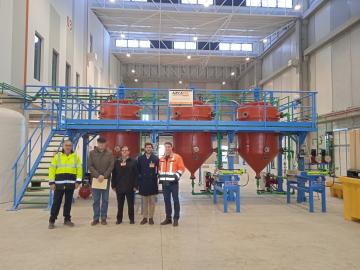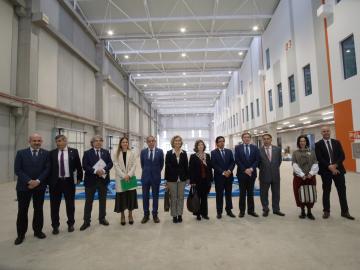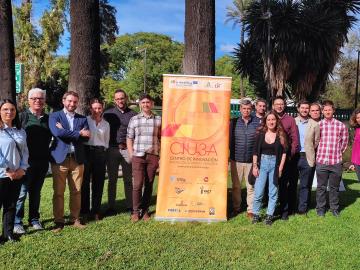Smart Factory Challenge: Industry 4.0 linked to GRI
The concept of Industry 4.0 covers the integration of different, both mature and emerging, technologies which, supported by their study and implementation, offer digital solutions for the development and improvement of industry. The project focusses on the study and development of new, advanced global Industry 4.0 solutions for Smart Factories based on Big Data, machine learning and simulation technologies and integrated and cyber-physical systems for monitoring the factory of the future
Chief researcher
Researcher
Location
Technology
Industry 4.0:
- Cyber-physical systems
- IoT – IIoT
- Big Data
- Digital Twin
- Cloud computing, Fog computing, Edge computing
- Machine learning
Allied agents
Summary of the proposal
The research, as part of the Industry 4.0 doctoral proposal, is structured into 4 blocks that are distributed over 4 years, and each block will be composed of its respective subtasks or derived technological applications.
Block 1 – Study of problems and technologies. This block comprises tasks based, firstly, on the study of the current state of the Industry 4.0 framework as well as the study of software and hardware architectures and sensoring systems linked to this technology; and secondly the process of manufacturing wind turbine towers that is carried out in the plant with all subprocesses.
Block 2 – System design. The prior automation of the factory’s manufacturing subprocesses will be carried out together with the study and the design of the data capture systems for the subsequent implementation of a big data analysis and storage system. This system will be connected to the company’s MES.
Block 3 – System development and implementation. Based on what has been studied and designed in previous blocks, the implementation of sensors in machines will be done, and the big data analysis and data management architecture will be put in place. In parallel, the company will define and obtain the KPIs to be used for the later study of the results, and to do so an MES system will be developed and integrated which will allow the analysis of these data and indicators, and their later optimization.
Block 4 – Conclusions. The thesis’s deliverables, along with the conclusions regarding the system designed, will be defined. New lines of future research will be proposed based on the system’s limitations.
Project goal
The main goal of the doctoral proposal is based on the study and generation of knowledge that will allow the future development of specific cyber-physical systems for the optimization of production processes in a plant that manufactures wind turbine towers, giving rise to a specific MES for the monitoring and optimization of production. This will be achieved by means of the collection, classification and analysis of data, through the use of big data and other technologies, with the aim of creating an interconnected, self-organizing plant based on the advances of Industry 4.0.
- Research into Cyber-physical Systems (CPS) to create Smart Factory settings that are optimum for the manufacture of offshore wind turbine towers.
- Design of systems for the detection of defects in the process of manufacturing offshore wind turbine towers.
- Research into sensor and augmented-reality systems that improve the productivity and precision of the process of manufacturing offshore wind turbine towers.
Expected results and indicators
The main expected results will cover the major technological challenges involved in the project, and what can be obtained at the first stage of each of them can be summarized as follows:
Design and development of CPS–IIoT architectures
Creating these kinds of architectures brings a challenge due to the numerous technological hurdles involved, as well as the complexity of having to adapt them to the manufacturing subprocesses carried out in the plant.
This last aspect must be taken into consideration given that one of the main challenges to think about is the size and importance of each of the pieces. While other production processes are characterized by the manufacture of many smaller, lower-cost elements in series, the plant’s production system is characterized by the manufacture of a smaller number of large-size pieces in which the unit cost is very high and each of the subprocesses involved is critical. This means that any error when developing and implementing these kinds of architectures is fatal in terms of time and costs incurred, and so this implementation needs to be precise and secure. However, despite the great challenges involving in the inclusion of these architectures for the reasons given above, their correct development would bring great advantages.
The expected results are based on the automation of production subprocesses given changes in conditions. This is achieved thanks to the information sent and received constantly by the machines, allowing them to adapt by themselves, depending on the environment. This aims towards different results in various areas:
- Reduction of breakdowns
- Increase in machine productivity
- Reduction of the cost linked to the piece (saving in personnel, down time…)
- Interconnection of the machines allowing them to adapt operation according to conditions
- Machine learning that allows the machine to adapt itself to changing conditions.
In short, what is expected is a more robust production system, making it more resilient and able to adapt quickly to any problems that may arise.
As academic indicators, it is expected that before 31 December 2021, the following will be done:
- 1 Conference
- 1 Indexed scientific article
Potential technological impact of the project (TRL)
Currently, industrial companies in Spain are facing great challenges in terms of positioning and establishing themselves on the global market due to the volatility and fast movement of the market, constant technological advances, global competition, more complex products and more challenging production. This is a major pressure on industries pushing them to scale up their level of digitalization in order to be able to adapt to production lines with new technologies, redefining the role played by humans and machines in the new processes.
Developments in industry and in production must take into account technological progress; in such a competitive and globalized world, an industry that is not open to innovation, the constant improvement of its processes and the use of emerging technologies could be condemning itself to disappearance. For this reason, the concept of Industry 4.0 has become an essential pillar of current research and for application in industry.




